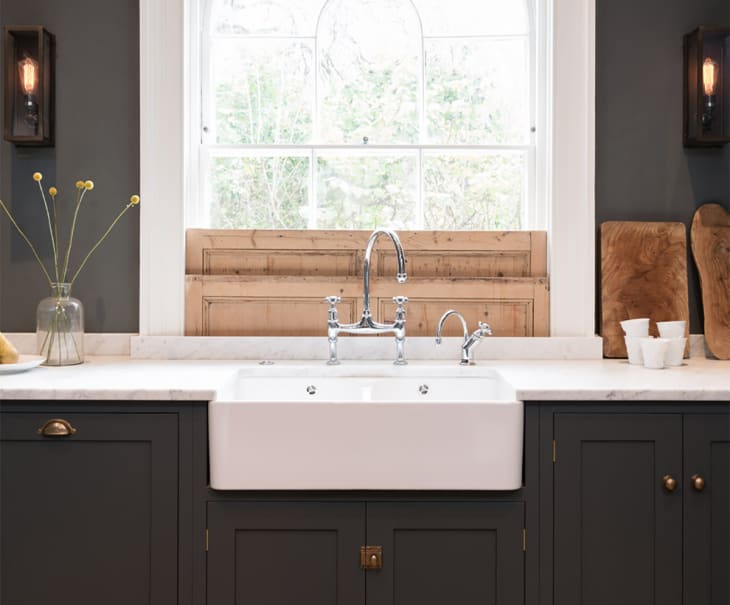Farmhouse Fabulous: All About Apron Sinks

The apron-front, or farmhouse, sink has been a popular fixture in all kinds of kitchens for some time now, and with the rise in popularity of kitchens that mix traditional and modern elements, it feels more appropriate than ever. If you’re considering adding one of these big beauties to your space, here’s everything you need to know.
Searching for a farmhouse sink? See all of our best picks here.
The design of the farmhouse sink is, as the name would imply, based on the sinks found in rural homes before the arrival of indoor plumbing. Designed to hold water brought to the kitchen from a pump or well, these sinks needed to have a high capacity.
Many people are initially drawn to the apron front sink for its unique look. These sinks, which often jut forward an inch or two from the countertop, make the sink an important design feature of the kitchen. Over the years, as the way we live becomes less and less formal, the kitchen has transformed from a hidden, utilitarian space to a an important gathering spot at the heart of the home, and open kitchens have become more and more common. The popularity of the farmhouse sink coincides with a movement towards kitchen fixtures that aren’t just functional, but attractive as well.
Usability
Besides its looks, the farmhouse sink has a few other advantages. Farmhouse sinks are typically bigger and deeper than traditional kitchen sinks, making it easier to washy bulky pots and pans (and maybe your dog or your child, if you so choose). Farmhouse sinks are also more ergonomic — because they extend past the edge of the cabinet, and eliminate the little strip of countertop at the front of a traditional sink, the user doesn’t need to lean forward to reach the sink, which could make a big difference to someone who spends a lot of time washing dishes or prepping food.
In some cases the farmhouse sink’s large size can actually be a disadvantage, though. Some taller people report finding them uncomfortable to use. Since the basin is deeper, this means that the bottom of a farmhouse sink will be a few inches lower than that of a traditional sink, which may be uncomfortable for a taller person.
Material Options
Farmhouse sinks come in pretty much any material sinks come in: fireclay, cast iron, stainless, copper, brass, even marble. If you’re considering buying one, it’s worth looking into this investigation of different sink materials. They are generally more expensive than their traditional counterparts, although prices and maintenance vary a great deal, from a few hundred dollars to a few thousand.
Installation
Apron front sinks are available in both undermount and topmount varieties. The undermount varieties, which fit under the surface of the countertop, have a more seamless look, and make it possible to sweep crumbs and liquids from the countertop directly into the sink. The seam between the countertop and the sink must be carefully sealed to prevent leakage.
A topmount farmhouse sink, although it will work with any kind of countertop, is a particularly good choice for a butcherblock countertop, since you don’t have to worry about water damage to the exposed edge of the countertop next to the sink. (If you’re pairing a farmhouse sink with a laminate countertop, you will have to use a topmount sink, since laminate countertops aren’t compatible with undermount sinks.)
In places where the sink and the countertop are made from the same material, it’s possible to have a farmhouse sink that fully integrates with the countertop. This looks expensive.
The undermount variety of farmhouse sinks generally do not include holes for the faucets and taps, so these must be mounted on the wall or on the countertop behind. Apron front sinks require a special cabinet to accommodate their depth and protrusion, so they are not the best candidate for retrofitting in an existing kitchen, unless you’re willing to replace your sink cabinet as well.
But if you’re considering a complete remodel, this may be a great option, especially if having a really eye-catching sink — with a really large capacity — is a top priority.